The loudest weapon in the anti-AI arsenal is the word consent. It has been smuggled into copyright law as if it belongs there. It never did. Consent has never been a standard in copyright. To apply it now would not just strangle AI — it would stifle the creative freedom that has defined art for centuries.
I don’t write this as a detached observer. I’ve spent two years in the trenches of generative art and music. Sixteen-hour days, endless prompting, 98% of takes discarded, the joy of finally coaxing a track into existence. I know what AI-assisted creation feels like — and I know a framing scam when I see one.
Consent Has Never Been Copyright
Copyright law grants a creator a limited set of exclusive economic rights: the right to reproduce, distribute, perform, and create derivative works. Others can license those rights. Others can also claim fair use — parody, commentary, transformation, or new functionality — without asking permission.
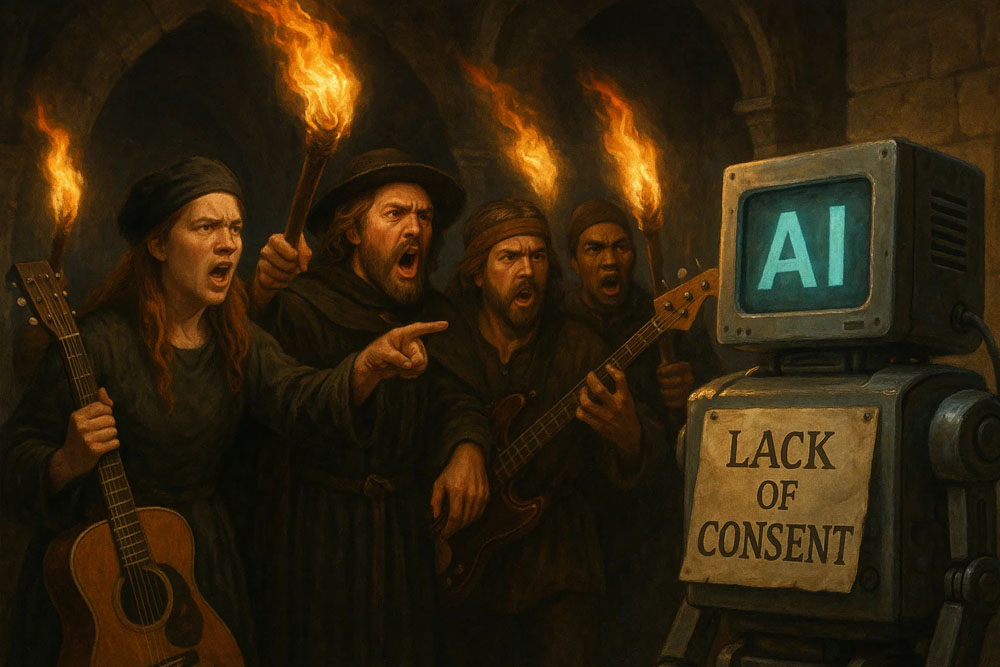
What copyright has never required is “consent” to be influenced. Nobody ever had to ask permission to listen to other music, to learn a style, or to internalize the sound of their predecessors. If that had been the standard, no art could exist.
Reciprocity: Apply It to Humans and Creation Stops
If AI models must obtain consent from every artist in their training set, then by parity of principle every human musician should have to produce written consent for every song, riff, or lyric that ever entered their ears. That is impossible. Nobody can remember the thousands of works that shaped their style. Nobody has a “consent archive” for their own brain.
Holding AI to a stricter standard than humans is not fairness — it is asymmetry masquerading as ethics.
Precedent: Art Has Always Borrowed
Art has never been created in a vacuum. It has always borrowed, recombined, and reinterpreted.
- Bob Dylan channeled Woody Guthrie, who himself drew from older folk traditions.
- Led Zeppelin famously drew from the American blues canon, reworking songs by Willie Dixon, Howlin’ Wolf, Muddy Waters, and other giants into their own catalog. “Whole Lotta Love” borrowed heavily from Dixon’s “You Need Love.” “The Lemon Song” echoed Howlin’ Wolf’s “Killing Floor.” “Bring It On Home” opened with a near-verbatim Dixon riff. Other tracks like “In My Time of Dying,” “Custard Pie,” and “Nobody’s Fault but Mine” were all direct reworkings of traditional blues and gospel songs. Lawsuits were brought, settlements paid, and credits eventually adjusted — but the band’s success was built on transformation, not consent.
- Zeppelin also arranged “Babe I’m Gonna Leave You,” initially believing it was a traditional folk tune. In reality, it had been written by Anne Bredon. Once discovered, Bredon was credited and compensated, but the arrangement itself was never questioned as legitimate authorship.
- Public domain works like Amazing Grace or House of the Rising Sun have been recorded countless times. Each new arrangement is copyrightable in its own right. Nobody asked the original composer for consent — because none was required.
- Bach’s Mass in B Minor directly lifted sections from earlier works by Kerll. Far from being condemned, this “borrowing” was considered the highest praise in 1733. No lawsuits, no outrage, only continuity.
What mattered in all these cases was expression and fixation: what the new artist added, arranged, or interpreted. Consent has never been part of that equation.
Existing Remedies Already Exist
If someone actually plagiarizes — lifts a melody, lyric, or chord progression wholesale — the law already provides remedies. Stairway to Heaven was litigated for years over Spirit’s Taurus, with courts weighing carefully the line between influence and infringement. George Harrison’s My Sweet Lord was judged to have subconsciously copied the melody of The Chiffons’ He’s So Fine, proving that even unintentional duplication can be addressed. Vanilla Ice’s Ice Ice Baby settled with Queen and David Bowie over its unmistakable lift of Under Pressure.
These cases show that courts already know how to handle true copying and provide damages when necessary. No new “consent” right is necessary; the system already distinguishes between inspiration and infringement.
Answering the “Unjust Enrichment” Claim
Critics insist AI creates “unjust enrichment” by profiting downstream without paying the original artist. The RIAA put it bluntly in its June 2024 filing: Suno was “commercializing music without consent, credit, or compensation.” GEMA echoed the same line in July 2025, calling AI training “exploitation of authors’ works without their consent.” The moral hook is obvious — cast AI as a profiteer, leeching value from defenseless artists.
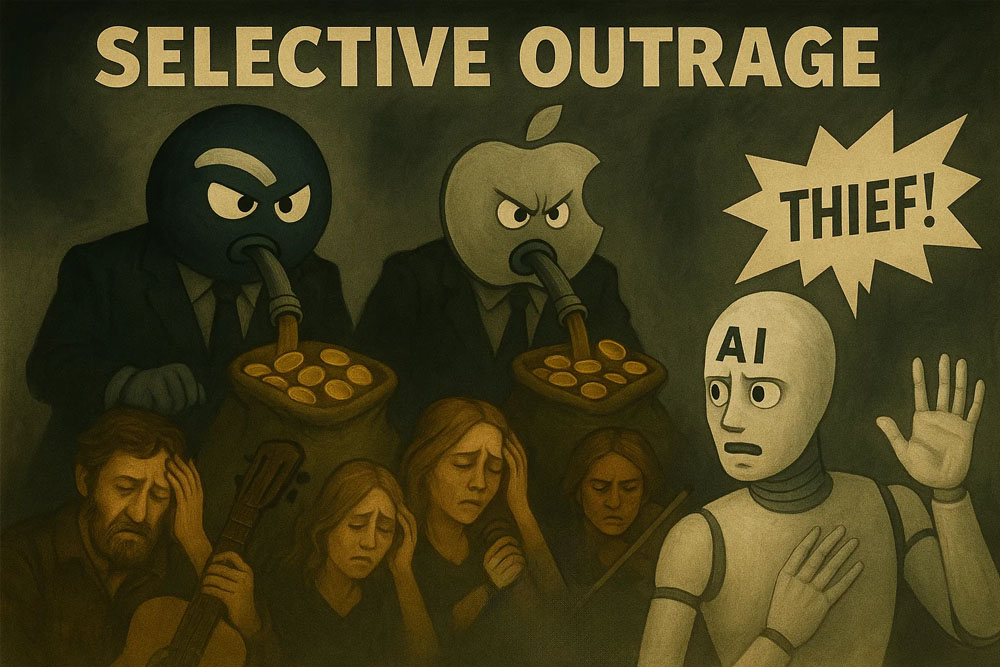
But this moral posturing distracts from the real culprits: streaming giants like Spotify, which pay artists $0.003 per stream, or Apple, which takes 30 percent of every download. These platforms have siphoned wealth from creators for over a decade, yet the outrage is suddenly reserved for AI. Why? Because “consent” is a convenient cudgel to rally sympathy, casting artists as victims of a new villain while letting the old ones off the hook.
It’s not ethics — it’s selective storytelling.
The Camera Analogy: Pressing the Button Isn’t the Art
When photography first emerged, painters denounced it in language nearly identical to today’s AI panic: “It’s cheating,” “It’s theft of reality,” “It will kill real art.”
History proved them wrong. The artistry of photography was never in pressing the shutter button. It was in the eye behind the lens — the framing, timing, composition, and editing that turned an image into art.
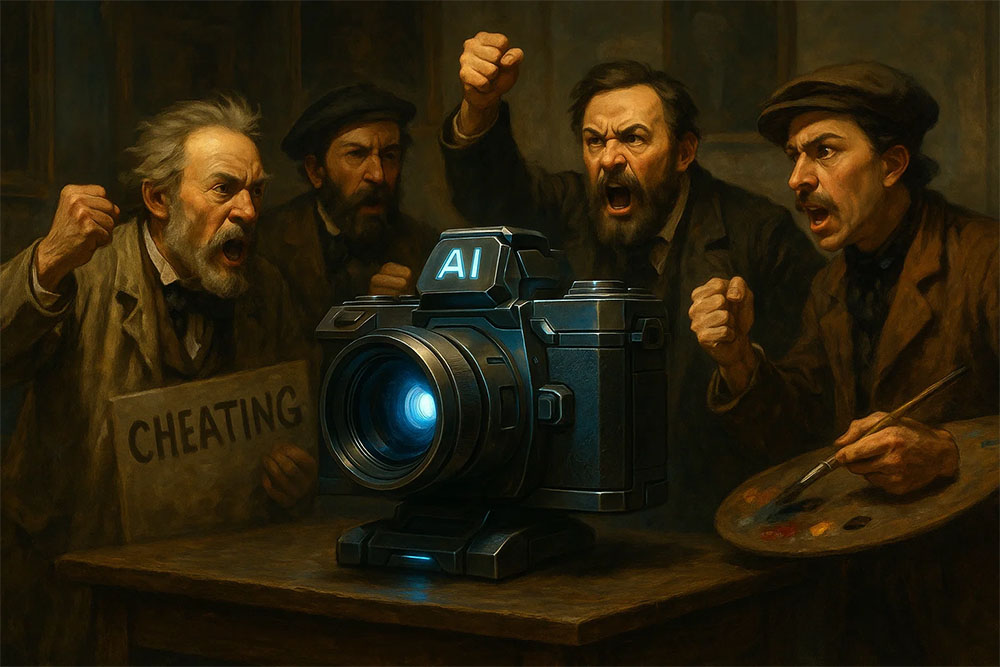
AI is no different. The artistry isn’t in pressing “generate.” It’s in the intent, iteration, rejection, and curation by the human creator. A thousand failed takes, discarded drafts, and refinements prove authorship lies with the person guiding the tool, not the tool itself.
To call this “theft” is to repeat the same mistake nineteenth-century painters made when they dismissed photography. We know how that story ends: the tool became an art form, and the gatekeepers were left behind.
A New Right Out of Thin Air
When musicians like Rick Beato or authors like David Baldacci demand “consent” for AI training, they aren’t defending existing copyright law. They are inventing a new right.
Copyright has always protected expression: the melody, the lyrics, the text, the recording. It has never protected style, voice, or influence. You can sound like Dylan, write like Hemingway, or paint like Van Gogh — and nobody can sue you for that.
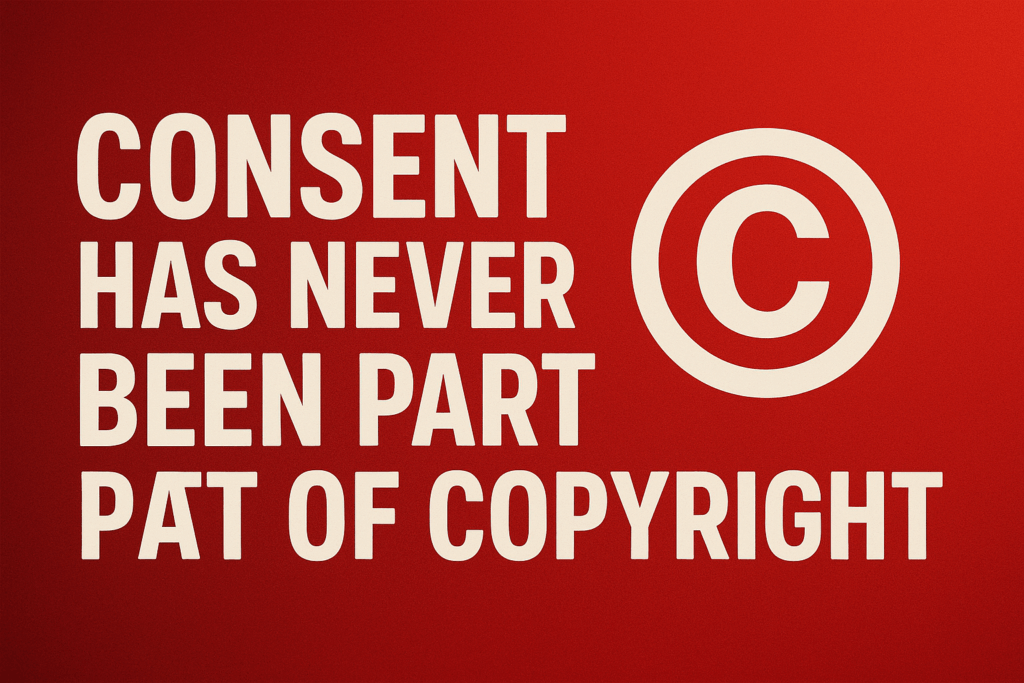
What the “no consent” lobby is really after is a power they’ve never had before: the right to control how others learn from, are inspired by, or imitate their work. In other words, a veto on influence itself.
That would be an unprecedented expansion of copyright — a world where every brushstroke, riff, or phrase became proprietary, and where both humans and machines would need permission slips before they could create. It would turn art into a permissioned economy, where the past is locked down to keep the present from competing with it.
This isn’t about protecting artists. It’s about protecting incumbents, freezing culture in place, and extracting new rents. Consent has never been a requirement for influence — and it cannot become one now without suffocating art itself.
The Real Game: Victim Theater
The rhetoric of “no consent” is designed to cast wealthy, heavily monetized artists as helpless victims. It borrows the moral charge of sexual assault language to paint corporations as predators and musicians as prey. It’s manipulative theater.
The lawsuits even wobble between “permission” and “consent” as if the two were the same thing. They aren’t. Permission is a licensing term. Consent is a moral trigger. By switching between them, plaintiffs launder a dry business dispute into a story of victimhood. It’s deliberate wordplay designed to win headlines, not arguments.
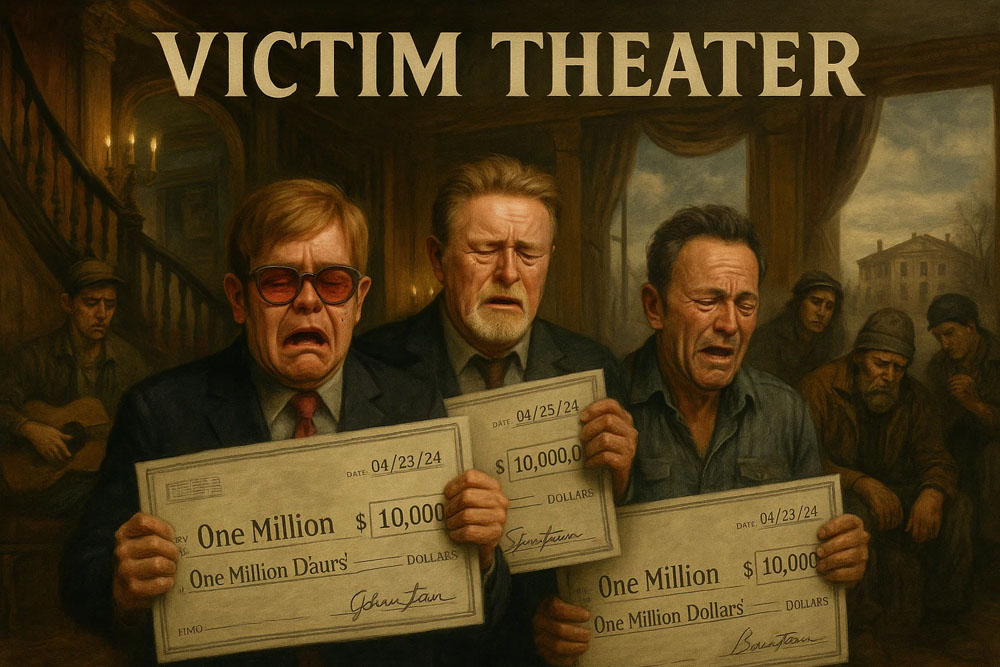
Look at the language: in June 2024, the RIAA thundered that Suno was using music “without consent, credit, or compensation.” Country singer Tony Justice went further, claiming artists were being “forced into an unconsented training role.” And in July 2025, German collecting society GEMA declared that AI models were “trained on protected works without the authors’ consent,” framing a technical dispute as an ethical violation. These phrases aren’t about copyright law — they’re about triggering cultural outrage, equating AI training with exploitation.
But artists who release work into the world are not victims. They made a choice. They took the money, they enjoyed the fame, and their art became part of the cultural bloodstream. That’s what publication means. You don’t get to publish for profit and then demand that the world act as if your work never entered its consciousness.
The Mousetrap Test: How “Consent” Kills Innovation
If “consent for influence” were the law, nobody could ever build a better mousetrap. The mere act of seeing or studying an existing design would count as “influence,” requiring permission from the original inventor. That would mean no improvements, no competition, no progress.
This logic doesn’t stop with mousetraps. By the same reasoning, nobody could:
- Design a faster car after looking at a Ford or a Chevy.
- Write new software after studying open-source code.
- Build a smartphone after using a landline.
- Learn medicine by reading past research.
The entire premise of innovation — the heart of capitalism — is that people learn from what came before, improve on it, and create something new. That process has never required consent from incumbents. If it had, the industrial revolution, modern medicine, and the internet would never have happened.
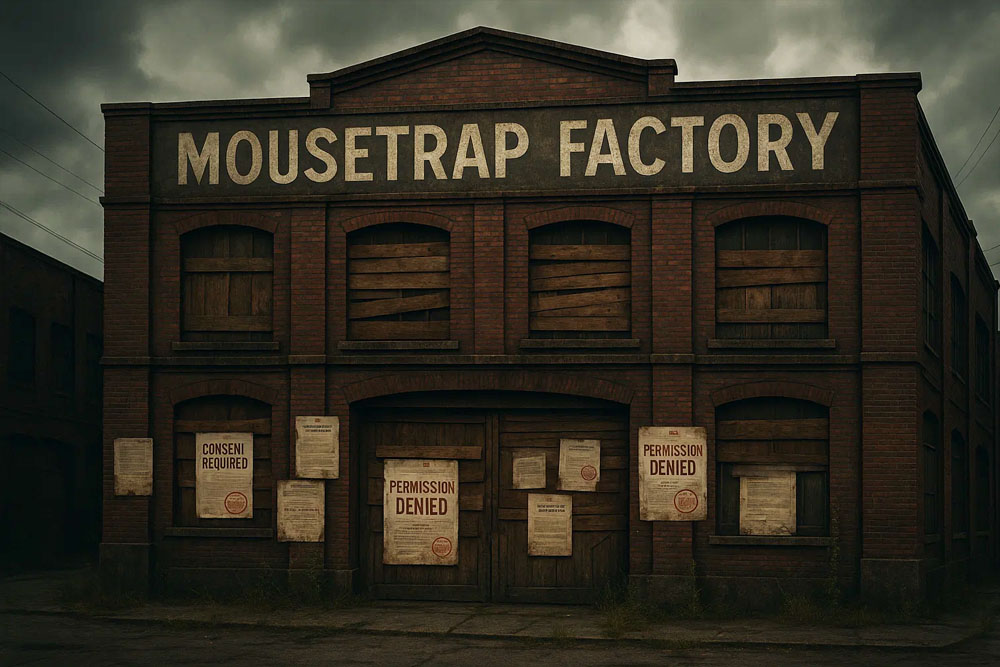
Art is no different. Musicians, writers, and painters have always absorbed what came before, reshaped it, and added their own vision. To suddenly declare that “influence requires consent” is not only anti-art — it is anti-progress. It would outlaw the very engine of competition that keeps society moving forward.
Conclusion: The Verdict
If “consent” were truly the measure, no art would exist. No musician could create. No painter could paint. No poet could write. Every work would be paralyzed by impossible permission chains.
Consent has its place in life. But in copyright, it is a fallacy. And the sooner we bury it, the sooner we can have an honest debate about AI and creativity.
So let us honor artists: publish their work, credit their genius, pay actual infringement damages when proven, and unleash AI as yet another tool of human creativity. Burdening the machine with guilt we never asked of the man only starves the next Bach waiting to be born.
— Wolfshead

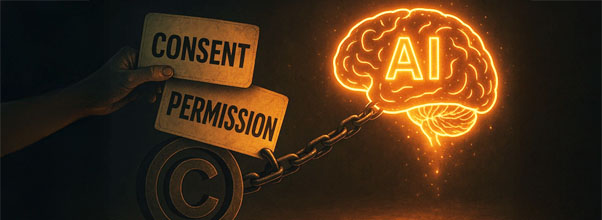

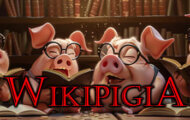

AI generation could take away income from music giants. They just want “their share” they do not deserve. So “consent” is just the current angle of attack, there will be others.
Exactly. I’ve got more articles coming out that reveal this tactic.